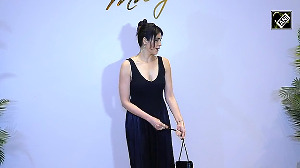There was some progress on World Trade Organisation talks on agriculture, with the European Union agriculture ministers agreeing to delink production from subsidies.
The US showed signs of softening its stand on trade-related intellectual property rights and public health.
Officials bracing for the tough negotiating ahead said talks on non-agricultural market access would gather steam once the two issues were resolved.
Like agriculture, the modalities for negotiating non-agricultural market access issues are yet to be finalised. The proposal put forward by the WTO has already raised a few eyebrows.
It is based on a formula, which seeks to put in place a tariff reduction mechanism factoring in the current rates of tariffs, which are to be multiplied by a co-efficient.
Trade experts say the co-efficient for developing countries and developed ones will be different, with the one for the advanced countries on the lower side, meaning that they will have to cut tariffs by a higher margin.
Tariffs are proposed to be reduced in three phases over 15 years, with India planning to ask for a 20-year implementation period for developing countries.
These countries are proposed to be given the flexibility in implementing the reduced tariffs, also keeping 5 per cent of their imports unbound.
In addition, it is proposed that countries remove duties on seven categories of products -- electronics and electrical goods, fish and fish products, footwear, leather goods, automobile components, textiles and stones, and gems and precious metals.
Japan has already raised objections to the removal of duties on fish and fish products and, trade experts say, the EU is against the formula itself, though no official stand has been taken.
The proposal, they said, was more in line with the US position, which sought steep duty reduction.
According to a commerce ministry study, India's average tariff base rates are estimated at 43.84 per cent, with average bound rates pegged at 34.3 per cent.
If the WTO proposal goes through, in the case of 2,005 of the 3,320 tariff lines, where the bound rate is now 40 per cent, duties will be reduced to anywhere between 14.2 per cent and 27.5 per cent, depending on the co-efficient. Industry is, therefore, apprehensive.
At a workshop on the issue organised by the Confederation of Indian Industry last week, most industry representatives opposed tariff removal in the seven sectors.
India has asked for special consideration for sectors like the small-scale, and also for the revenue factor for exchequers in developing countries.
Trade analysts expect India to begin by opposing the zero-for-zero proposal. Anwarul Hoda, professor at Icrier, said the plan could be avoided.
Besides, he said it did not make sense for countries to agree to the proposal if general tariff levels were not brought down significantly.
For instance, in the case of automobile components, where tariff elimination was proposed, Hoda said unless India removed duties on steel, the automobile parts sector would not take off.
"High tariffs on steel can't go with zero tariffs on automobile components. That will be reverse tariff escalation, and it will destroy industry because steel will not be available at low duties," he explained. Experts say industry needs to be more realistic in its stand.
"Industry must realise that it is not them versus the government of India, but India against 145 countries," said a trade expert at an industry chamber.
TRIPS and public health
At a time when the TRIPS and public health imbroglio is close to resolution, the EU has put forward a proposal at the WTO asking the multilateral trade body to ensure affordable supply of medicines to the poor, while not discouraging the development of new medicines.
It has asked countries to ensure that low-price products from least developed and developing nations should not flow into high-price markets.
The EU has pointed out that the administrative and legal framework to ensure protection of patent holders, with a system for transparent and expeditious procedures, are absent in several countries.





 © 2025
© 2025